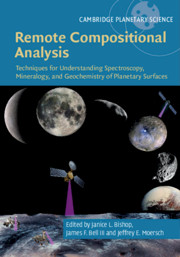 Remote Compositional Analysis
Remote Compositional Analysis Laboratory Spectra of Geologic Materials
from Part I - Theory of Remote Compositional Analysis Techniques and Laboratory Measurements
Published online by Cambridge University Press: 15 November 2019
Middle infrared (~2000 to 200 cm–1 or 5 to 50 μm) data are extremely useful for compositional determination of geologic materials because this wavelength region hosts the fundamental (“Reststrahlen”) vibrational bands of most minerals. Analysis of remotely sensed data requires comparison to well-developed spectral libraries populated with a wide variety of mid-IR mineral spectra (and additional rock or meteorite spectra). Here we present the theory behind molecular vibrations of mineral structures and the simple harmonic oscillators that define them mathematically. We present dispersion theory that describes how energy travels through a crystal and how propagating energy is affected by the crystal lattice structure, specifically along the various crystal axes. The equipment required for these types of laboratory measurements (both emissivity and reflectivity) is presented as well as a discussion about how mid-IR data are affected by particle size and how related volume scattering affects spectral data. Finally, mid-IR emissivity spectra acquired in a dry, 1-atm environment are provided for 93 different minerals and meteorites. These spectra are available as ancillary data files.
To save this book to your Kindle, first ensure [email protected] is added to your Approved Personal Document E-mail List under your Personal Document Settings on the Manage Your Content and Devices page of your Amazon account. Then enter the ‘name’ part of your Kindle email address below. Find out more about saving to your Kindle.
Note you can select to save to either the @free.kindle.com or @kindle.com variations. ‘@free.kindle.com’ emails are free but can only be saved to your device when it is connected to wi-fi. ‘@kindle.com’ emails can be delivered even when you are not connected to wi-fi, but note that service fees apply.
Find out more about the Kindle Personal Document Service.
To save content items to your account, please confirm that you agree to abide by our usage policies. If this is the first time you use this feature, you will be asked to authorise Cambridge Core to connect with your account. Find out more about saving content to Dropbox.
To save content items to your account, please confirm that you agree to abide by our usage policies. If this is the first time you use this feature, you will be asked to authorise Cambridge Core to connect with your account. Find out more about saving content to Google Drive.